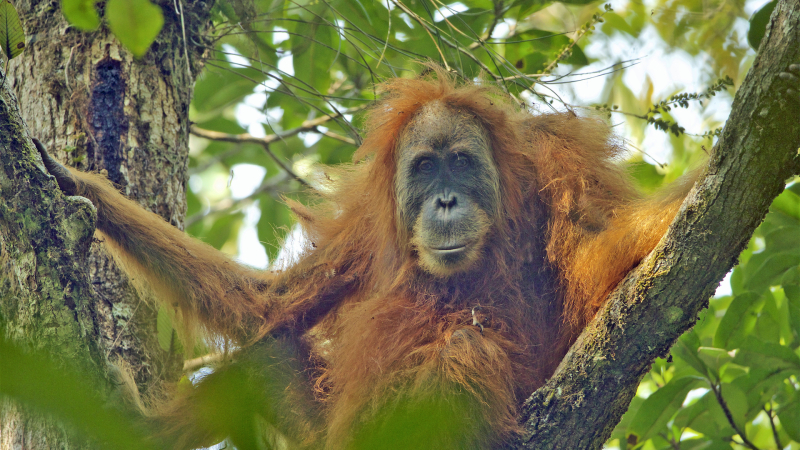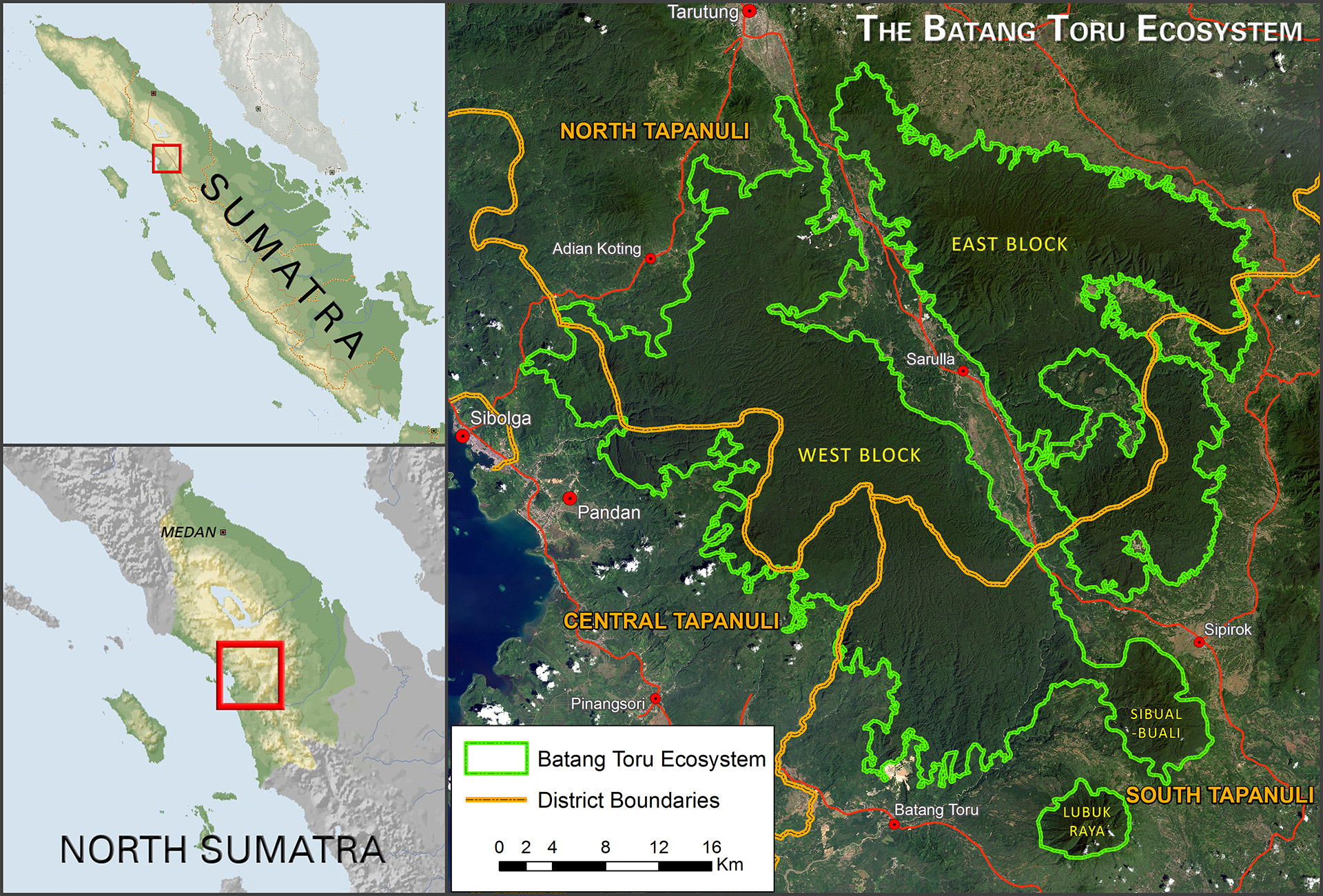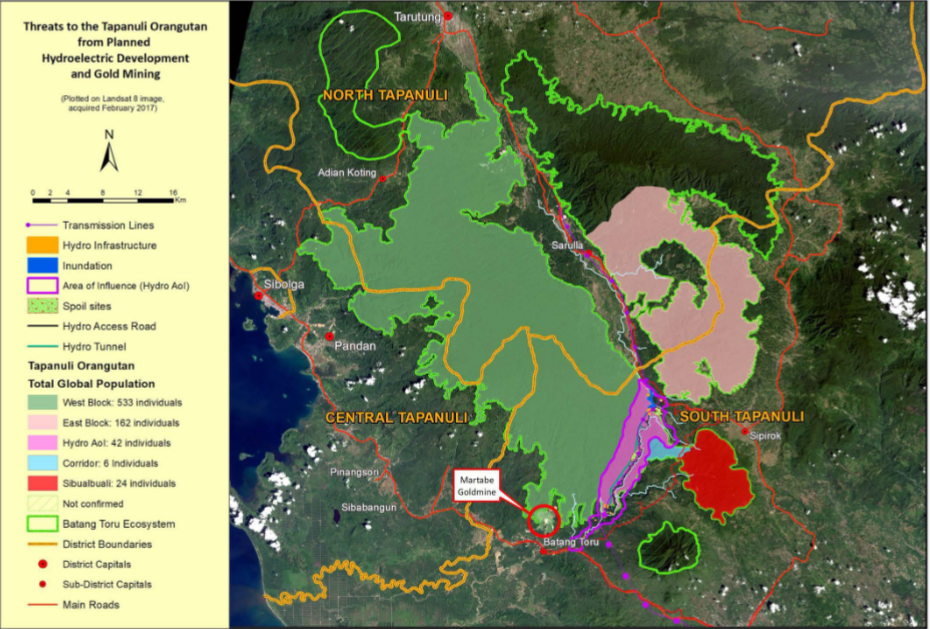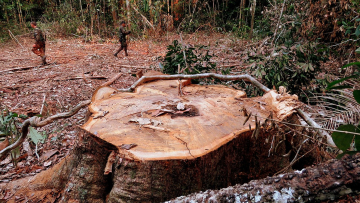Project – On record
This profile is no longer actively maintained, with the information now possibly out of dateFriends of the Earth US
Amanda Hurowitz, Mighty Earth, amanda@mightyearth.org

Project – On record
This profile is no longer actively maintained, with the information now possibly out of dateFriends of the Earth US
Amanda Hurowitz, Mighty Earth, amanda@mightyearth.org
Why this profile?
The Batang Toru Dam will have potentially irreversible environmental, social, and biodiversity impacts on the North Sumatra region in Indonesia. The Batang Toru ecosystem is a critical habitat for many endangered species including Sumatran tigers, sun bears, agile gibbons, and pangolins. This ecosystem is the only known habitat of the newly discovered Tapanuli orangutan, of which less than 800 currently remain – making it the most endangered Great Ape species in the world. If built, the Batang Toru Dam project will likely doom the Tapanuli orangutan to extinction.
What must happen
PT NSHE and Sinohydro should immediately halt all operations, and remove already built infrastructure, including roads and bridges, which is currently giving access to poaching, illegal logging and land speculation. Given the high densities of orangutans at the project site, any further disturbance will have severe consequences for the Tapanuli orangutan.
Reputable independent consultants should immediately conduct a new environmental impact assessment. Given the presence of critically endangered species and the impacts on downstream communities, this will undoubtedly show that Batang Toru is not a suitable location for a hydroelectric dam.
To ensure the long-term survival of the Tapanuli orangutan, the Indonesian government must give legal protection to the whole Batang Toru forest. This will prevent similar threats emerging in future.
| Sectors | Hydroelectric Power Generation |
| Location |
|
| Status |
Planning
Design
Agreement
Construction
Operation
Closure
Decommission
|
The Batang Toru Dam is a proposed hydroelectric dam project in the fragile Batang Toru ecosystem, North Sumatra. The project is expected to generate 510 MW electricity for six hours a day and will occupy several hundred hectares of prime habitat along the Batang Toru River in the South Tapanuli district, but would impact a much larger area. Currently, land is being developed and cleared for the project. PT North Sumatra Hydro Energy (PT NSHE) is developing the project, originally announcing plans for the hydropower plant in 2012. The dam is slated to become operational by 2022 and is expected to cost USD 1.67 billion.
Impact on human rights and communities
The dam will radically alter the nature of downstream water courses, significantly impacting the local people. Investigations into the project in Indonesia have brought to light poor planning and financial mismanagement, whilst overinflated prices for generation indicate possible corruption. It will produce electricity during periods of peak demand, typically between 6pm and midnight. During the day, the river will be blocked and the reservoir above the dam will gradually fill up, to be released later through the tunnel and turbines to generate electricity. Downstream communities, which normally experience drought and flood cycles a few times a year, will now have to learn to cope with them on a daily basis.
The dam’s construction has cost the lives of 18 construction workers and local people, following a series of landslides and tunnel collapses. Campaigners report a pattern of intimidation against those who challenge this project in Indonesia, including the death of WALHI lawyer Golfrid Siregar under suspicious circumstances in 2019. In 2023, a public discussion on the dam was violently disrupted, prompting condemnation by free speech and press rights groups.
Impact on nature and environment
Flawed impact assessment The environmental impact assessment (EIA) is deeply problematic. While it recognizes the existence of the many of the problems listed below, including the presence of orangutans and other endangered species, it fails to address the full impacts the dam will have on wildlife, or other problems such as mitigation measures for the impacts on downstream communities.
Risk of extinction The Batang Toru forest is home to the entire remaining population of Tapanuli orangutans, the most endangered great ape species in the world. The new project poses a very real threat of extinction for this entire species. Many more endangered species will be severely impacted, such as Sumatran tigers, sun bears, agile gibbons and pangolins.
Threats to fisheries and river ecology The dam will split the river in two, preventing fish and other species from migrating along the river. This will have serious impacts on fish like jurung, an extremely important and highly valued source of food and income for local communities.
Threats from pollution Despite being billed as a ‘green’ project, like all large hydroelectric projects the Batang Toru dam will emit significant quantities of greenhouse gases, contributing to climate change. These emissions originate from the manufacture of the massive amounts of concrete and other materials needed for construction. They are also emitted by decomposing vegetation in the flooded reservoir above the dam, especially methane, which as a greenhouse gas is 30 times more potent than carbon dioxide. Other dam reservoirs have also led to increased concentration of methylmercury in the aquatic food chain, which is known to cause brain and nervous system damage.
Risk of earthquakes Batang Toru lies in the middle of an earthquake hotspot: the region has the highest density of earthquakes in mainland Sumatra. There is also mounting evidence that reservoirs can themselves trigger earthquakes, due to the increased pressure created by large bodies of water. If an earthquake were to strike and rupture the dam when the reservoir was full the consequences for those living downstream would be catastrophic (Damming Evidence report 2018).
The Batang Toru Dam is expected to cost USD 1.67 billion. After the Bank of China pulled out of financing the project, citing environmental concerns, it was bought in late 2021 by the Chinese State Development & Investment Corporation (SDIC Power).
SDIC holds a 70% stake in PT North Sumatra Hydro Energy (PT NSHE), the project sponsor, alongside the Indonesian State-owned electricity monopoly (PT PLN through its subsidiary PT PJB Investasi, who hold 25%), with the rest held by Asia Hydra: owned by two executives linked to Malaysian conglomerate Genting Berhad.
November 24 2022, SDIC agreed to raise funds to complete the project through a loan syndicate scheme led by the Export-Import Bank of China (CHEXIM). SDIC will provide full-amount whole-process joint liability guarantee up to USD 1,251 million, with the guarantee period not more than 18 years.
In 2018, the World Bank and the Asian Development Bank shied away from supporting the Batang Toru Dam project in Indonesia over environmental concerns. In April 2019 Bank of China stated that it would re-evaluate its financing of the Batang Toru Dam project, eventually pulling out completely.
Power China, the parent company of Sinodydro who holds the Engineering, Construction and Procurement contract for the dam, has been excluded from the Norwegian Government Pension fund over the extinction threat to the Tapanuli orangutan.
PT North Sumatera Hydro Energy (PT NSHE) is a joint venture owned by the parent companies: PT DHN (52.8%), Fareast Green Energy (22.2%) and PT PJB Investasi (25%).
In June 2022 the Financial Times reported that SDIC Power, a Chinese state-owned company, had acquired a 70% interest in the project (Financial Times).
Project sponsor
PT North Sumatera Hydro Energy (PT NSHE)
IndonesiaOther companies
Location of the Batang Toru ecosystem (Friends of the Earth):

Five zones of habitation of the Tapanguli orang-utan (Mighty Earth report Jan 2020):

New Species of Orangutan Is Rarest Great Ape on Earth | Nat Geo Wild
New species of great ape discovered
2022
2022-06-19 00:00:00 | Chinese state-owned company SDIC Power invests in Batang Toru dam endangering rare orang-utangs
Chinese state-owned company, SDIC Power, that trumpeted its green credentials when listing on the London Stock Exchange (LSE) has quietly acquired a development in Indonesia that scientists warn threatens the world’s rarest great ape. The company signed off plans to invest in the USD 277 million Batang Toru hydropower plant in Indonesia less than two months after completing a listing in 2020 that was backed by big western banks and strongly supported by the LSE (Financial Times).
2019
2019-03-14 00:00:00 | Bank of China to evaluate Batang Toru hydropower plant project
Bank of China has said it will evaluate its funding commitment to the Batang Toru hydropower plant project in North Sumatra amid environmental concerns. “Bank of China will evaluate the project very carefully and make prudent decisions by duly considering the promotion of green finance, fulfilment of social responsibility as well as the adherence to commercial principles,” the bank said in a statement posted on its website (The Jakarta Post).
2019-03-07 00:00:00 | Bank of China faces international day of action over Batang Toru finance
On March 1st, 2019, activists in cities around the world staged protests outside Bank of China branches and Chinese diplomatic missions to protest the bank's links to the Batang Toru dam. Wahli (Friends of the Earth Indonesia) and Friends of the Earth US helped to coordinate the actions. On March 4th, Bank of China responded, in a rare engagement from a Chinese bank, saying it "will evaluate the project very carefully and make prudent decisions by duly considering the promotion of green finance, the fulfilment of social responsibility as well as the adherence to commercial principles."

